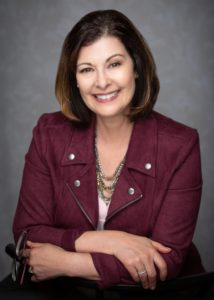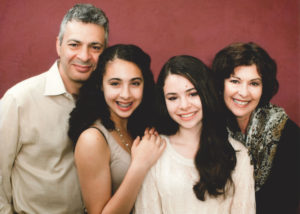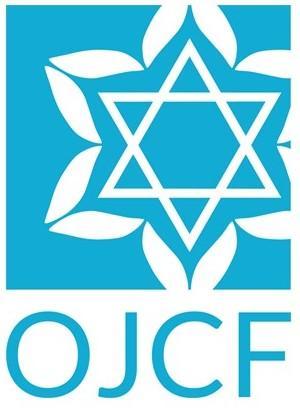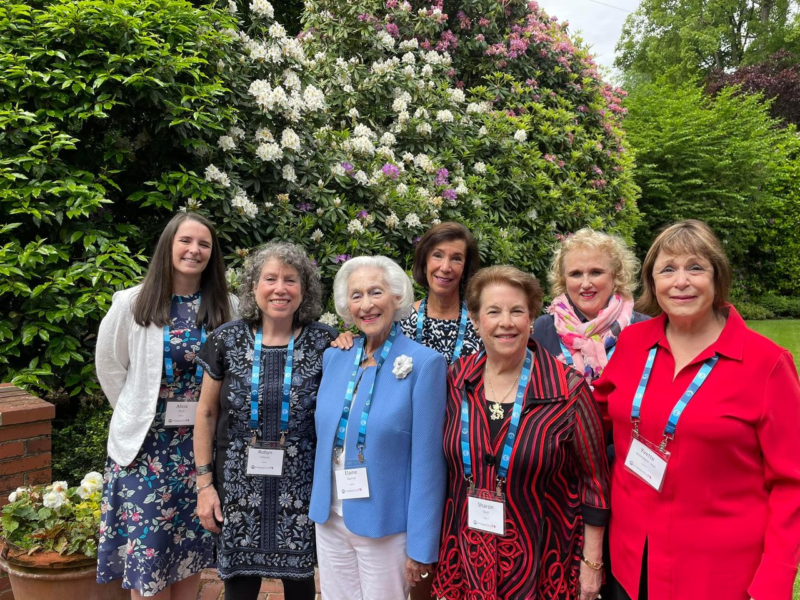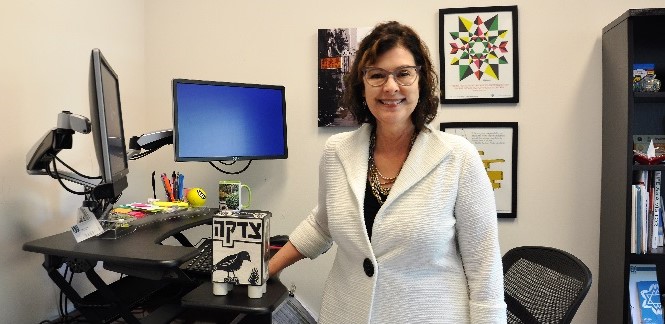
Julie Diamond leads community foundation as it helps ensure Jewish future
As it approaches its 30th birthday, the Oregon Jewish Community Foundation has far exceeded the dreams of its “parents.”
At age 10, the foundation had already far surpassed the founders’ goals. When Julie Diamond was hired as director of development in 2007, OJCF had more than $43.4 million in assets under management. She was named executive director in 2010. Despite a dip in assets during the “Great Recession,” under Julie’s leadership OJCF continued its growth trajectory and now has nearly $90 million in assets under management and an estimated $25.8 million pledged in Declarations of Intent (legacy gifts).
“We are doing the same thing with the same purpose – long-term planned giving and endowments to support the future of our Jewish community,” says Julie.
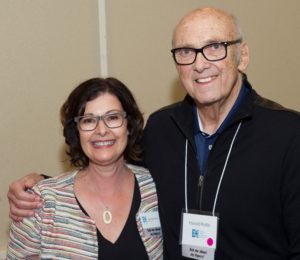
OJCF President and CEO Julie Diamond with OJCF creator Harold Pollin at the 2017 annual meeting. Photo by Naim Hasan Photography
She says the whole point of the foundation is “to support our donors in their philanthropy in ways that are rewarding, impactful and sophisticated … to sustain Jewish communal life for generations to come.”
OJCF launched in 1989 with five partner organizations – Jewish Federation of Portland, Mittleman Jewish Community Center, Jewish Family & Child Service, Robison Jewish Home and Portland Jewish Academy – and about $2.8 million in assets. The foundation is now the endowment and investment partner for 30 organizations and congregations. OJCF is also home to 245 donor-advised funds and endowment funds, which allow local donors to give based on their personal passions.
“I would not have predicted it would be the size it is now,” says Harold Pollin, who proposed the creation of the community foundation and served as its first board president. “We would have been satisfied with $10 million by 2000 (OCJF managed $30 million by that date). I am very proud of the fact that our community created the fund and it is doing so well.”
Of Julie’s leadership, he adds, “She brought a fresh perspective to the work and has built the organization substantially. She writes and talks very effectively … and people will listen to her.”
JULIE DIAMOND: PROFESSIONALLY & PERSONALLY
Julie grew up in the San Francisco Bay area. Her parents, Mimi and Leonard Lewitt, were from Brooklyn. At home, Judaism was important and fun – “a celebration of food, culture, food, holidays and tradition.” They attended a Reform congregation whose “dynamic young rabbi was super involved in social justice,” where Julie’s passion for social action and getting involved took root.
In California, Julie had a career in marketing, public relations and branding in a startup. Her first Jewish nonprofit job was at Jewish Family Service in Sacramento.
“I met the JFS director at a seder, and she was looking for someone to help them grow,” says Julie, who was hired as director of development and marketing. “My business skills were very attractive for a small nonprofit.”
She and her husband, Tom, moved to Oregon in 2003 as a “life choice.” Tom, who works for Intel, was able to transfer to the company’s Oregon campus when their daughters were in preschool and first grade. The girls attended Portland Jewish Academy through eighth grade then went to Sunset High School.
“My parents have graciously followed me around on my adventures,” says Julie. “Until my daughters went to college, we had three generations here. My parents went to all the PJA plays and open houses.”
Daughter Melissa, 21, is a senior at the University of Washington in Seattle. Rachael, 19, is a sophomore at Scripps College in Claremont, CA.
When the family moved to Oregon, Julie worked briefly at the Mittleman Jewish Community Center then became a performing arts ad rep for a company that published airline magazines.
She also did a lot of volunteering and met OJCF’s then Executive Director John Moss.
“I was really interested in supporting the foundation and did some pro bono consulting and worked on the first OJCYF (youth foundation) dinner with Michelle Gradow and Sharon Morell (who went on to become OJCF’s first woman board chair).”
“John created the position of development director, and I was hired to support growth,” says Julie. When John semi-retired a couple of years later, Julie was named interim director and then executive director in 2010. Under a bylaws change in 2017, her title became president and CEO.
Jim Meyer, who served as OJCF’s second board president, notes that many organizations from around the state have become OJCF partner organizations since Julie took the reins.
“Partly it is the growth of the organization, but partly it is because people trust Julie,” he says. “Julie has earned their trust.”
“Julie has done a great job, and she has brought in excellent people,” Jim adds regarding the new staff members.
Current board Chair Steve Laveson agrees that the quality and quantity of staffing has increased. With only four staff 10 years ago, Steve says the staff was overworked and the technology was lagging behind. “Now we have a level of staff as well as more people, and the IT (information technology) is there. We have vastly better capability to grow at this point.”
OJCF Director of Philanthropy Gail Mandel, who was hired when Julie was the interim director, has strong views of Julie as a leader: “She really cares about the Jewish community as a whole and wants to see it grow and thrive. … (It’s) why she pursues this work and why she has brought a new energy to the foundation as a leader. ”
Gail says Julie is collaborative, inclusive, has a good sense of humor and is realistic. “She wants to see the foundation be strategic in its outreach and initiatives. We are a small team and she is mindful that we do what we do well … and don’t stretch too thin.”
Steve adds that it has been nice to see Julie grow in her abilities from her start in development.
And Julie continues to grow. During the recent strategic planning process undertaken by the board and staff, Julie says she saw there were things she could do better to meet the objectives of the plan (see “Looking Ahead” below). This fall she enrolled in a certificate program at Portland State University’s Center for Executive and Professional Education. During the coming year she will take four courses to earn a certificate in strategic organizational management.
She also has a busy life outside of work. “I’m an avid dance fan and regularly attend performances of Oregon Ballet Theatre and NW Dance Project. I also take adult ballet, along with yoga and Pilates classes. I volunteer with the NW Planned Giving Roundtable and am on their executive committee.”
As recent empty nesters, she and Tom are exploring ways to have fun together. Tom has long been an avid long-distance cyclist, whereas Julie “likes to hop on a bike for fun.”
“He has helped me expand by abilities,” says Julie. “Now we look for a middle ground that works so we can be together and be outside.” Last year they went on a multi-day cycling tour near Santa Barbara, and this year they cycled in the Saguaro National Park outside Tucson.
“We are both reflecting about time, health and work/life balance,” she says.
LOOKING AHEAD
When Julie joined OJCF in 2007, she was the foundation’s fourth staff member. The foundation’s staff has grown to seven “passionate, involved and knowledgeable” professionals.
“We have an elevated level of sophistication on the staff and board and are able to handle more complex gifts of real estate and business shares,” Julie says. For example, a recent $1.7-million gift of real estate funded the creation of two new family donor funds. “It is a pleasure to see what we have all accomplished together.”
Another challenge is educating donors about the impact of tax changes. Bunching donations into one year, such as through creating or contributing to a donor-advised fund, enables taxpayers to take a charitable deduction in the years they itemize, while continuing to support organizations that are important to them in the years they take the standard deduction.
In June the OJCF board approved a new three-year strategic plan.
“We will work on strategic imperatives such as improving the community’s knowledge of OJCF’s role, enhancing donor services and stewardship, and deepening relationships with families through focused work in intergenerational family philanthropy,” says Julie.
“One of the challenges to OJCF looking forward is the changing giving patterns of the younger generations – millennials and Gen X,” she says, noting that social justice tends to drive giving for those generations, who are less likely to support organized religion or be members of traditional synagogues. “That’s why we have a ‘strategic imperative’ to work in the area of intergenerational family philanthropy and help families explore Jewish values and responses to passions for making a difference that are changing generation to generation.”
Hospitals and arts organizations have long had a focus on creating endowments and legacy giving, notes Julie. “The Jewish community was getting left out.”
“The biggest challenge is accepting that change takes time,” she adds.
LEGACY GIVING
Promoting legacy (after-lifetime) giving has been an important part of OJCF since its founding. The foundation’s first newsletter in summer 1990 included a “Letter of Intent” form that people could complete to commit to supporting the foundation with a lifetime gift or bequest in their will.
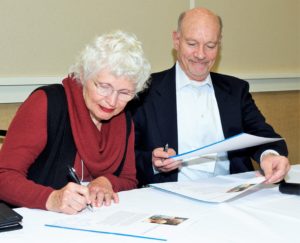
OJCF Book of Life – Kay and Roy Abramowitz sign their Endowment Book of Life page. Roy, a member of OJCF’s board, and his wife, Kay, have made a legacy gift to support OJCF’s youth foundation. The Book of Life is an evolving collection of stories from Oregon and SW Washington’s legacy donors, of which there are now 72. The book is on display at the Mittleman Jewish Community Center or can be viewed online at ojcfbookoflife.org. BY NAIM HASAN PHOTOGRAPHY
Embracing the concept of legacy giving has an inherent obstacle.
“People need help to talk about planned giving and endowments, because it requires thinking about dying, and people don’t want to think about that,” Julie says. “The answer is to think about the legacy and passing their values to the future – and looking at protecting family assets and acknowledging and celebrating family values.”
To facilitate such meaningful conversations, the foundation works with financial planners, says Julie. “Financial planners talk about the same issues, but may never have thought about the value of asking (their clients), ‘Have you thought about including a charitable organization or charitable giving in your estate plan?’ ”
Another challenge is that many Jewish organizations have limited staff to promote planned giving.
Endowment giving received a tremendous boost in 2013 when OJCF partnered with the Harold Grinspoon Foundation to bring its Life & Legacy program to Oregon. For four years, the program provided training and incentive grants to 10 local organizations. At the end of the fourth program year, those 10 organizations had secured 516 Declarations of Intent with an estimated future value of $25.8 million. For meeting their goals, the organizations also received incentive grants from the Grinspoon Foundation and OJCF’s Endowment Fund.
“With incentive grants, Life & Legacy rewards organizations in the present for (obtaining) future returns that they may not see for decades,” says Julie, explaining one of the reasons L&L has been so successful.
Nationally, 52 communities with 558 organizations have participated in Life & Legacy. At the end of 2017, a total of 17,627 legacy commitments had been secured by partner communities in North America with an estimated future value of $672 million.
Gail Mandel, who has managed L&L since it arrived in Oregon, says, “It has really been interesting to see how it has succeeded. We only had funds for 10 organizations.”
She says originally the organizations were skeptical about collaborating, because they feared they would lose donors to other organizations. OJCF and the Grinspoon Foundation helped alleviate those concerns through group trainings in which the organizations shared ideas,
roadblocks and successes. “Slowly everyone realized when one organization benefits, others benefit, too. The majority of people sign letters of intent for more than one organization. When we all collaborate and work together, it is for the good of the larger community.”
All of OJCF’s L&L organizations have agreed to continue a structured program, which Gail calls Life & Legacy Light, for a fifth year.
“It’s a testament to organizations realizing endowments are so important to having a strong future,” she says. “The staff and lay leaders have endorsed that it is worthwhile to spend time to cultivate legacy donors.”
“Life & Legacy is a wonderful collaborative success story,” says Gail. “I think because of it, the community will be stronger in the future.”
CELEBRATING SUCCESS
At the foundation’s 30th anniversary gathering in June 2019, OJCF will honor the past, celebrate the present and embrace the future.
A strong future for the Jewish community has been the focus of foundation leaders throughout OJCF’s existence.
“I have a lot of respect for Harold,” says Jim Meyer. “When he got this idea, he thought it had to be set up so the agencies were equal members of the foundation. It turned out he was right. When he proposed it, the agencies were very willing to come in as full partners.”
Jim attributes the early success to many individuals who brought their skills to the table to ensure the foundation was established with the correct language and structure. He mentions early leaders including Henry Blauer, z”l, Sol Menashe, Stephen Kantor, Dick Solomon and Bob Glasgow.
“I feel very privileged I was involved early and got it going,” says Harold Pollin. “It was a wonderful team effort, and it has paid off in spades.”


